Perovskite Solar Cells: The Key to the Future Expansion of Renewable Energy in Japan.
Part 2: Efforts toward Early Public Implementation
(Provisional translation)
(English ver.) 2024-06-10

Film-type perovskite solar cells displayed at the site of the G7 Hiroshima Summit 2023
(Source) Sekisui Chemical Co., Ltd.
Perovskite solar cells are attracting attention as the key to the future expansion of renewable energy toward achieving carbon neutrality by 2050. This article presents in two parts everything you need to know about perovskite solar cells, with Part 1 highlighting the characteristics of perovskite solar cells as well as the status of technological development. Here, Part 2 presents situations in other countries regarding the development of perovskite solar cells. It also highlights efforts being made by Japanese companies as well as support measures taken by the Government of Japan.
The Government of Japan supports private companies’ efforts toward commercialization
Perovskite solar cells are light and flexible. This allows them to be introduced in spaces where it is hard to install conventional solar cells. They can be mass produced by a small number of production processes, and cost reductions are anticipated. Furthermore, the primary material for producing perovskite solar cells is iodine, and Japan has the second largest share (about 30%) of its global production. The Government of Japan established the Project for Developing Next-Generation Solar Cells with a budget of 49.8 billion yen under the Green Innovation Fund* to support companies’ efforts for developing this promising technology and is aiming for its public implementation by 2030.
*Green Innovation Fund: METI established the Green Innovation Fund with two trillion yen under the FY2020 Tertiary Supplementary Budget and assigned the New Energy and Industrial Technology Development Organization (NEDO) to operate it.
Several private companies, taking advantage of this support measure, have been advancing R&D toward establishing manufacturing technology for perovskite solar cells.
Sekisui Chemical Co., Ltd.

It develops film-type perovskite solar cells that are light and flexible and can be installed on building walls and roofs that can only support small loads.
(Source) Sekisui Chemical Co., Ltd.
Toshiba Corporation

It manufactures film-type solar cells by applying meniscus printing technology to achieve both an increase in the power conversion efficiency and a fast production process.
(Source) Toshiba Corporation
Kaneka Corporation
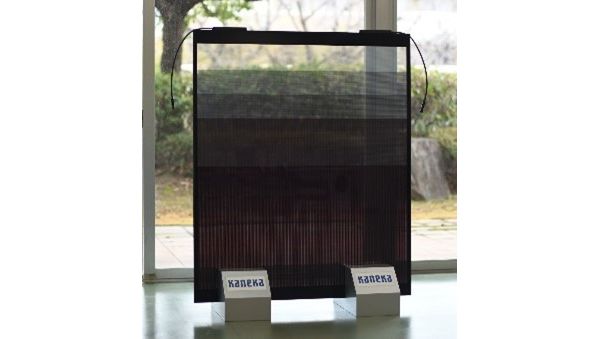
It aims to manufacture building materials with built-in perovskite solar cells. It advances technological development by taking advantage of its expertise in the mass production of silicon-based solar cells.
(Source) Kaneka Corporation
EneCoat Technologies Co., Ltd.
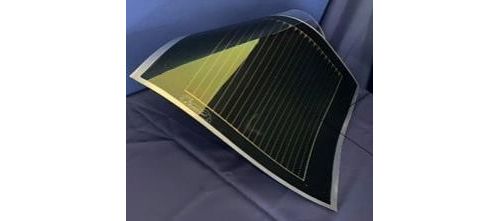
A spin-off from Kyoto University, it develops perovskite solar cells with the aim of applying them to IoT devices and buildings.
(Source) EneCoat Technologies Co., Ltd.
Aisin Corporation
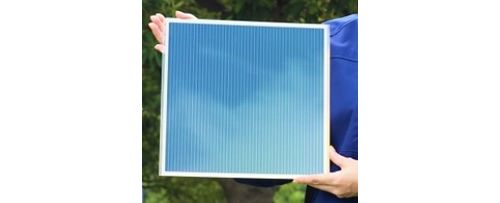
It develops a spray engineering method to evenly apply perovskite materials.
(Source) Aisin Corporation
For instance, Sekisui Chemical Co., Ltd. has developed light and flexible film-type perovskite solar cells that can be installed on building walls and roofs that can only support small tolerable loads. The company has created a 30 cm-wide roll-to-roll manufacturing process* that enables continuous production, and it has confirmed outdoor durability equivalent to 10 years. Furthermore, this manufacturing process has been successfully used to produce film-type perovskite solar cells with a power generation efficiency of 15.0%.
*In this manufacturing process, printing or application is conducted while multiple drum rolls convey the products.
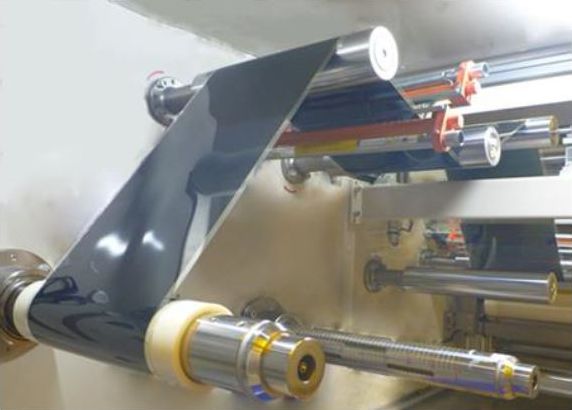
The roll-to-roll manufacturing process
(Source) Sekisui Chemical Co., Ltd.
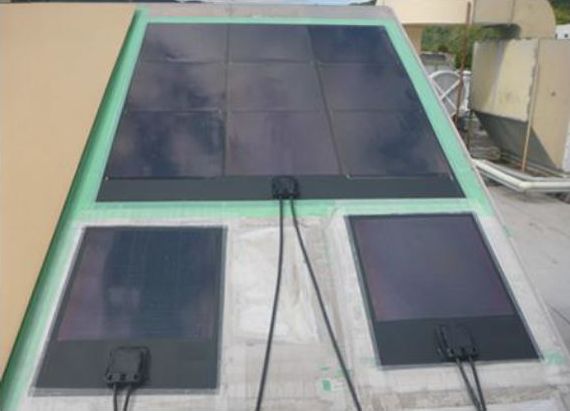
An experiment conducted on the rooftop of Sekisui Chemical’s research laboratory
(Source) Sekisui Chemical Co., Ltd.
Sekisui Chemical will install film-type perovskite solar cells in the public square of Umekita (Osaka) Station, which is scheduled to be fully open in 2025. The company has also announced other demonstration projects in collaboration with its customers, including the world’s first installation of 1-megawatt-plus perovskite solar cells on the walls of a high-rise building.
Representations of the Redevelopment Project in Uchisaiwaicho 1-chome Urban South District
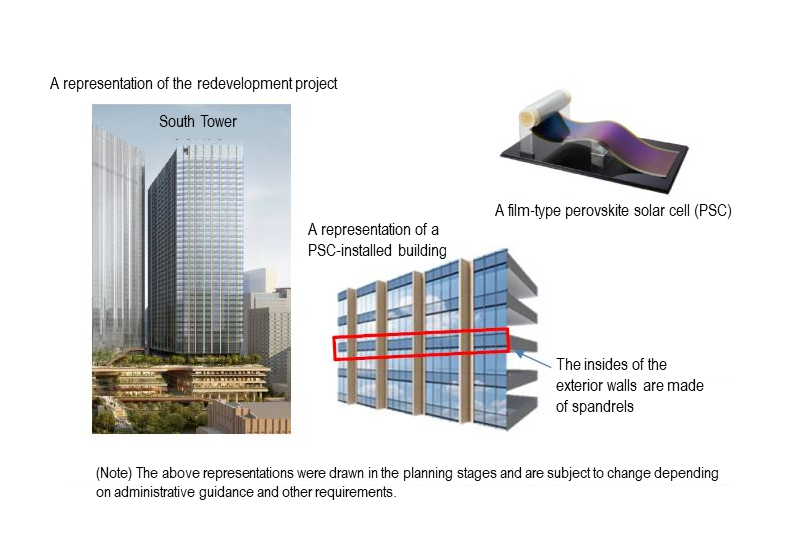
(Tentative name) Uchisaiwaicho 1-chome Urban District Development Project
(Source) Sekisui Chemical Co., Ltd.
Toward early public implementation
While there is a certain amount of progress in R&D in Japan, global competition is intensifying. Developments are rapidly advancing in other countries, such as China, the UK, and Poland, with some mass-production projects underway. Japan needs to achieve public implementation of this technology before 2030 if it wants to beat the global competition.
In August 2023, the Working Group (WG) on the Promotion of Green Electricity under the Green Innovation Project Subcommittee of the Industrial Structure Council decided to increase its budget for development projects by 15 billion yen to 64.8 billion yen to promote early public implementation of this technology. Going forward, we will endeavor to expand demonstration projects, such as the development of base technologies, the commercialization of large-area module efficiencies, and large-scale production technologies.
Technologies for scaling up perovskite manufacturing must be developed as soon as possible to enable commercial production of perovskite solar cells. It is also essential to establish production systems and create initial demand.
Future policy directions toward early public implementation of next-generation solar cells

(Source) Sector-Specific Investment Strategies (Next-Generation Renewable Energy) taken from the website of the Cabinet Secretariat
To realize early public implementation, it is essential to build a domestic supply chain for scaling up manufacturing toward popularizing perovskite solar cells. To this end, the Government of Japan decided to provide support for building a supply chain to develop manufacturing bases. The GX Implementation Council compiled the sector-specific investment strategies, which included “support measures for building a supply chain to develop manufacturing bases.” The FY2024 draft budget includes building a supply chain for perovskite solar cells in addition to water electrolysis equipment and floating-type offshore windmills. The draft budget allocates 54.8 billion yen (totaling 421.2 billion yen including public dept liabilities) to the GX Support Project for Building a Supply Chain.
To further popularize perovskite solar cells globally, it is necessary to establish international standards to evaluate their performance. The G7 Ministers’ Meeting on Climate, Energy and Environment held in Sapporo in April 2023 adopted the Ministers’ Communique that included the following statement:
“Specifically, we will promote improvement in innovative technologies such as
perovskite solar cells and floating offshore wind power, wave energy and in international
standards of evaluation methods for introducing new technologies under international
coordination.”
Japan will make further efforts internationally while advancing R&D and public implementation domestically.
Divisions in Charge
About this article
New and Renewable Energy Division, Energy Efficiency and Renewable Energy Department, ANRE
About the Special Contents
Research and Public Relations Office, Commissioner’s Secretariat, ANRE
![]() The original Japanese text of this article; Click here
The original Japanese text of this article; Click here